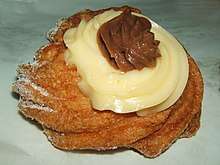Zeppole
A zeppola (Italian: [ˈdzeppola]; plural: zeppole; sometimes called frittelle, and in Sardinia the italianized zippole or zeppole sarde[1] from the original Sardinian tzípulas[2]) is an Italian pastry consisting of a deep-fried dough ball of varying size but typically about 4 inches (10 cm) in diameter. This fritter is usually topped with powdered sugar, and may be filled with custard, jelly, cannoli-style pastry cream, or a butter-and-honey mixture. The consistency ranges from light and puffy, to bread- or pasta-like. It is eaten to celebrate Saint Joseph's Day, which is a Catholic feast day.[3]
 Zeppola | |
| Alternative names | Saint Joseph's Day cake, sfinge, Bignè di San Giuseppe |
|---|---|
| Type | Pastry |
| Place of origin | Italy |
| Main ingredients | Dough, powdered sugar, fried dough |
History
Zeppole are typical of Italian cuisine, especially that of Rome and Naples. They are also served in Sicily, on the island of Malta, and in Italian communities in Canada and the United States. The Sardinian tzipulas, even though they are often italianized to zeppole, are somewhat different. Zeppole are known by other names, including Bignè di San Giuseppe (in Rome), St. Joseph's Day cake, and sfinge.[4] Zeppole are traditionally consumed during the Festa di San Giuseppe (Saint Joseph's Day) celebrated every March 19, when zeppole are sold on many streets and sometimes presented as gifts.
In Istria, Croatia this pastry is called blenzi in the Croatian speaking places and zeppole in the Italian-speaking places.They are always topped with sugar either powdered or coarse.
The custom was popularized in the early 19th century by Neapolitan baker Pasquale Pintauro.[4]
Varieties

The terms zeppole and sfinge are also used to refer to baked cream puffs made from choux pastry.[4]
Some zeppole are filled with ricotta mixed with small pieces of chocolate, candied fruits and honey. In some parts of the U.S., they are called crispellis.
Zeppole can also be savory, and consist of fried bread dough often filled with anchovy. In parts of Calabria, the anchovy or a sultana variety are consumed on New Year's Eve and New Year's Day. In Malta, anchovy zeppoli are traditionally consumed during the Lent fasting period.[5] This version of savoury zeppole are known locally as Sfinge. The sweet version is also available in many confectioneries.
In the region of Frosinone in Southern Lazio the term "Sfinge" refers to a mixture of ricotta, sugar and eggs with the flour, which can then be flavored with vanilla, almond, etc. It is still fried in ball shapes served covered with confectioner's sugar.
See also
References
- "Zippole" (in Spanish).
- "Ditzionàriu in línia de sa limba e de sa cultura sarda".
- Brown, Ellen (2015). Donut Nation: A Cross-Country Guide to America's Best Donut Shops. Running Press p. 53. ISBN 978-0-7624-5525-6.
- Zeldes, Leah A. (March 17, 2010). "Eat this! Zeppole for St. Joseph's Day". Dining Chicago. Chicago's Restaurant & Entertainment Guide, Inc. Retrieved March 19, 2010.
- Chetcuti, Kristina (1 April 2010). "Rabat's specialty for Lent – sfineġ". Times of Malta Online.